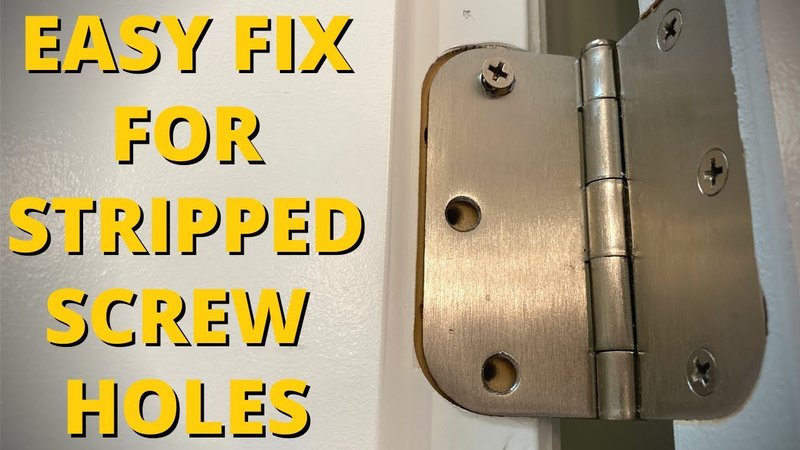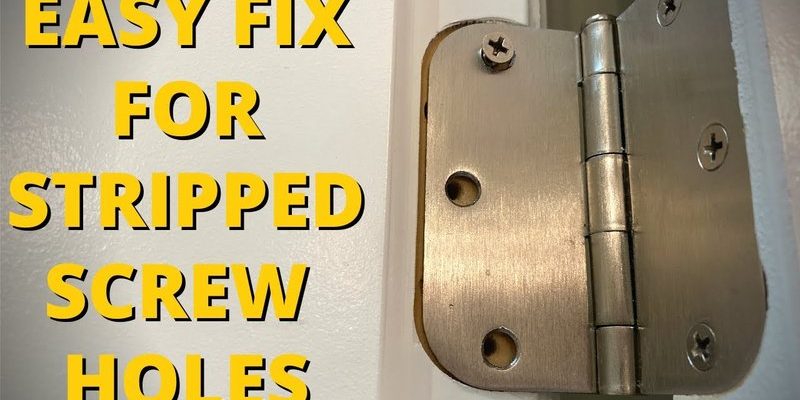
Hinge screws are often an overlooked aspect of home upkeep. As you use your doors, the repeated motion and weight can cause these screws to gradually back out, just like how a cork can slowly rise from a wine bottle if not secured tightly. But fear not! In this guide, I’ll walk you through some effective ways to keep those screws in their rightful place. Whether you’re dealing with interior doors, cabinet doors, or heavy exterior doors, there are simple steps you can take to prevent hinge screws from backing out over time.
Understanding Why Hinge Screws Loosen
Let’s start by understanding why hinge screws tend to loosen in the first place. Imagine every time you open or close a door, it creates a tiny bit of movement in the hinges. This constant tension and pressure can cause the screws to vibrate and loosen over time.
Several factors contribute to this screw-loosening phenomenon:
- Wear and Tear: Just like any mechanical part, hinges experience wear and tear. The more you use your door, the more strain the screws endure.
- Temperature Changes: Wood and metal expand and contract with temperature fluctuations. This can affect how tightly your screws fit.
- Type of Material: If your screws are made of lower-quality materials, they’ll wear down faster, weakening their grip.
Understanding these factors can help you see the importance of preventing this problem. It’s not just about aesthetics—it’s about functionality and safety, especially when door integrity is concerned.
Choosing the Right Screws
One of the first steps to preventing hinge screws from backing out is ensuring you’re using the right kind in the first place. Not all screws are created equal!
Here are a few tips for selecting the right screws:
- Length Matters: Make sure your screws are long enough to hold the hinge securely in place. A longer screw provides more grip, reducing the chances of it loosening.
- Material Quality: Choose screws made of high-quality materials, like stainless steel or brass. They resist rust and corrosion better than cheap alternatives.
- Type of Thread: Look for screws with coarse threads for better grip in wood. Fine threads can slip out more easily.
By choosing the right screws, you’re setting a solid foundation for long-term stability. It’s like building a house on a strong base—you want everything firmly in place.
Using Thread-Locking Products
You might be wondering, “Is there a quick fix for screw issues?” The answer is yes! Thread-locking products, like Loctite or similar adhesives, can be a game changer. These special adhesives are designed to prevent screws from loosening due to vibrations.
Here’s how to use them:
1. Clean the Area: Before applying, make sure the screw and hinge area are clean and free of dust or grease.
2. Apply Thread Locker: Carefully apply a small amount of thread locker to the screw threads.
3. Reinsert and Tighten: Screw it back into place and tighten it securely. The adhesive will bond as it dries, creating a strong hold.
With this method, you can significantly reduce the chances of your screws backing out. Remember, though, it’s not a substitute for regular checks and maintenance.
Regular Maintenance Checks
Now that you’ve got the right screws and possibly some thread locker, the next step is simple: regular maintenance checks. It’s important to make this a habit. Checking your door hinges every few months can help you spot any screw loosening before it becomes a bigger issue.
Here’s a quick guide on how to do it:
1. Visual Inspection: Look closely at the hinges for any signs of gaps or misalignment.
2. Test the Screws: Use a screwdriver to gently tighten the screws. They shouldn’t need much effort—if they do, it’s a sign they were already loose.
3. Listen for Odd Noises: If you hear squeaking or creaking when moving the door, that’s another sign your screws may need tightening.
Think of this process like a quick check-up for your doors. Just a few minutes of attention can save you from larger headaches down the line.
Using Hinge Washers
Another great tip to prevent hinge screws from backing out is to use hinge washers. Washers provide a bit of cushion between the screw head and the hinge. This helps distribute the load more evenly, reducing wear on the screws over time.
Here’s how to use hinge washers:
1. Choose the Right Size: Make sure to select washers that fit well with your screws and hinges.
2. Remove the Screw: Unscrew the hinge and place the washer on the screw shaft.
3. Reattach the Hinge: Screw it back in place.
Using hinge washers is like adding a protective layer; it keeps everything secure and stable for the long haul.
Consider Heavy-Duty Hinges for Heavy Doors
If you have particularly heavy doors, standard hinges may not cut it. Heavy-duty hinges are designed to bear more weight and are less likely to have screw issues.
When considering heavy-duty options, keep these points in mind:
- Material Strength: Opt for materials like stainless steel or reinforced metal.
- Design Quality: Look for hinges that have a robust design, which often means they’ll hold screws better.
- Rated Capacity: Check that the hinge is rated for the weight of your door. If it’s too light-duty, consider upgrading.
Upgrading may seem like a big step, but it can save you a lot of hassle in the long run, especially if you’re dealing with frequently used doors.
Final Thoughts
Preventing hinge screws from backing out over time doesn’t have to be a daunting task. With a few smart choices, regular checks, and some helpful products, you can ensure your doors stay functioning smoothly.
Remember, it’s all about being proactive. Whether you start by choosing the right screws or incorporating thread-lockers into your routine, every little effort counts. By paying attention to these details, you’re not just maintaining your doors—you’re ensuring a safer and more pleasant environment in your home. Keep those hinges tight, and you’ll enjoy comfortably swinging doors for years to come!
